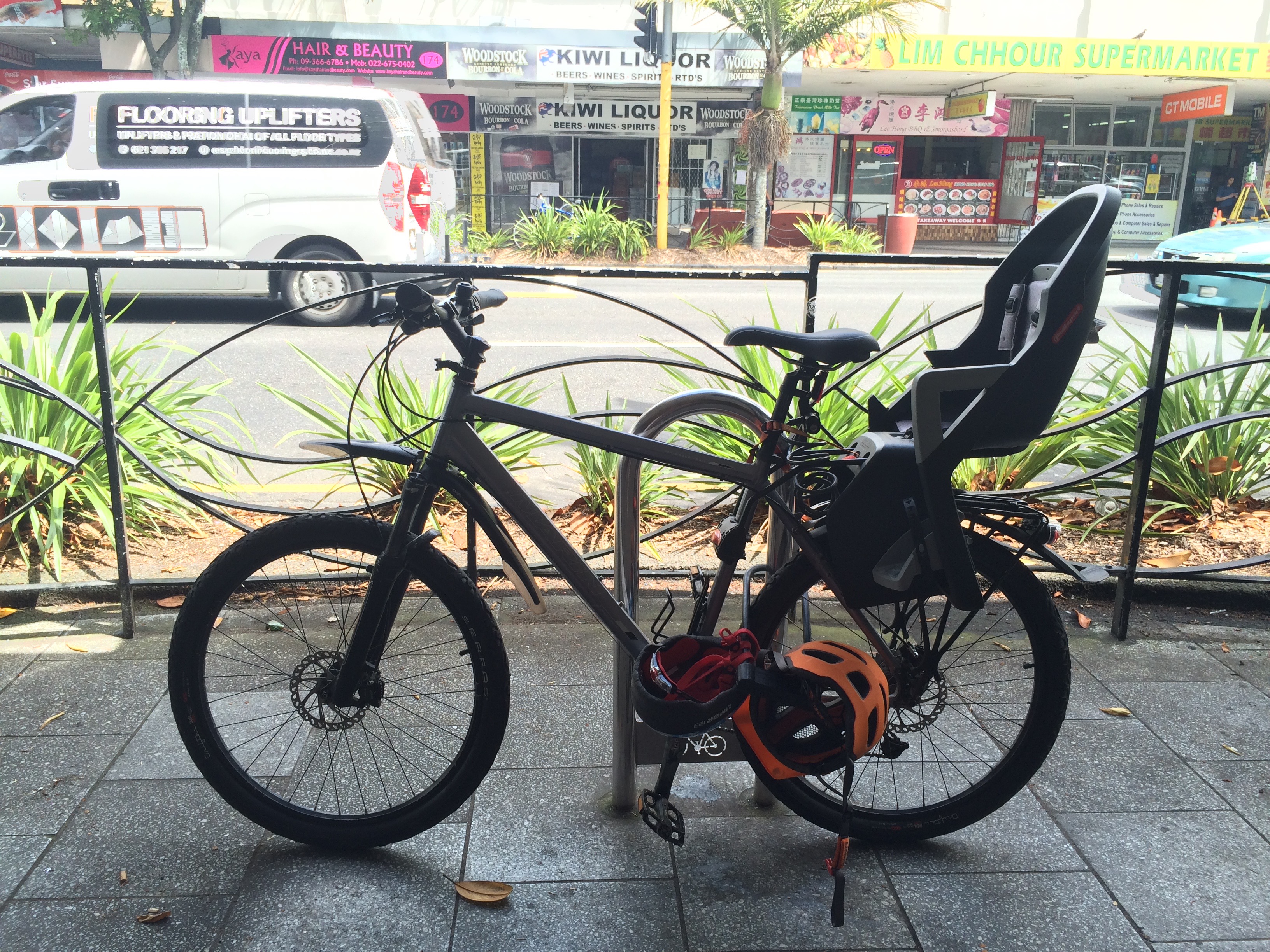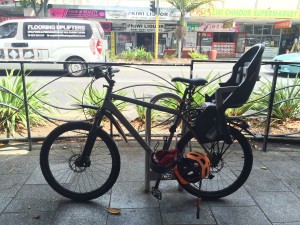 Karangahape Road – where the Open Streets event will happen on Sunday 1 May, 12-7! – is one of the most interesting streets in Auckland – I think even people who dislike it would agree. It has something more than just heritage, more than just activity, more than just being central and urban. It has… layers. Layers on layers.
Karangahape Road – where the Open Streets event will happen on Sunday 1 May, 12-7! – is one of the most interesting streets in Auckland – I think even people who dislike it would agree. It has something more than just heritage, more than just activity, more than just being central and urban. It has… layers. Layers on layers.
From the original Maori roots, when it was a major local through-route as well as a gathering place and prominent ridgeline overlooking the whole isthmus, to the early European times when the settlers quickly found similar use for it as both a place of travelling through and stopping.
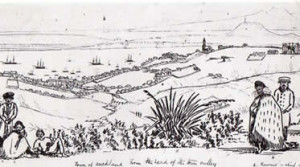
Then came the layers built by European settlement – the history of St Kevin’s Arcade, just to give one example, reads like a novel. From the 1840s the spot was the location of a scoria house, known as Mr Keven’s House, occupied by a series of notable Aucklanders including Governor George Grey, and the Kinder family.
Much altered and redecorated, the house was finally demolished at the end of WW1 to make way for the St Kevin’s Arcade Building we know and love today. These were the gardens of the old house.
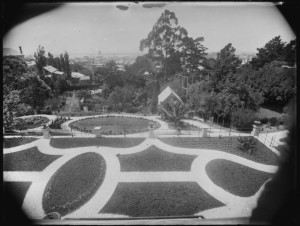
And of course, these civic layers were quickly followed by the layers of commerce, which within mere decades turned small single-storey shops into gleaming multi-storey department stores, centrepieces of Auckland’s shopping, entertainment and society.
Entertainment, society? Well, for example until a recent heritage tour, I had no idea that, in the early decades of the 20th century, the rooftop garden restaurant of the George Court department store building (on the corner of K Road and Pitt Street, now subdivided into apartments within the old shell) was THE place to be for visiting jet-setters (it was actually the steamship age, but you get the idea – that’s where Lorde would have taken a visiting Taylor Swift for tea and publicity, if they’d lived back then).
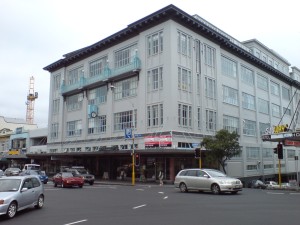
Down on the street, meanwhile, K Road was heaving with shoppers on the long shopping evenings, with shops being closed on weekends. People also flocked to the area to frequent places like the Mercury Theatre (a cinema).
Then of course came the motorways, cutting off K Road from its surrounding residential suburbs and destroying many of these areas at the same time, often even with a ‘we’re better off without these mouldy shacks’ mantra of urban renewal. Many of the houses may indeed have been in bad repair, but the purported surgery almost killed the patient. It certainly drove many out of the area.
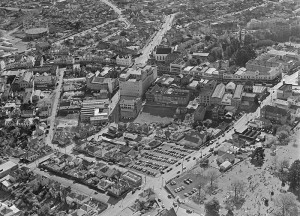
Next, the trams got ripped out, which made getting to K Road harder. The larger stores on K Road hung on for a few more decades – ironically, by funding a joint car park (in Cross Street, connected to the shops by ‘Skyways’). A valiant but ultimately doomed bid to compete with surburban malls for car customers.
The next stage brought decline, but also the seeds of art, nightlife, and character (or more to the point – more character, and different character). Low rents allowed bars, sex shops, clubs and other venues to flourish, and develop an alternative scene to a more staid suburban life just a few kilometres away – giving K Road the name and edgy reputation that it still has to a degree today, even if it has since changed again massively.
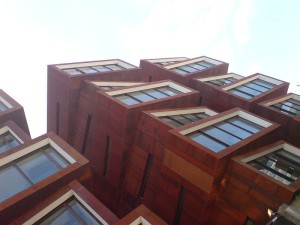
Now of course, there is new development, funky buildings like Ironbank, new apartment buildings especially at the western end like on Howe Street – and refurbishment of old buildings, like the recent controversial spruce-up of St Kevin’s Arcade.
There are fears of gentrification, and gentrification that has already happened over the last 10-20 years, and a simple growth in the number of people. More people living in the area, and one of the busiest train stations of Auckland coming right on the doorstep in the next decade. Change is happening, for better or worse, and yet the street to keep its heart.
Enter the urban cycleway project, which, on K Road, has found one of its greatest challenges – but also potentially, its greatest rewards.
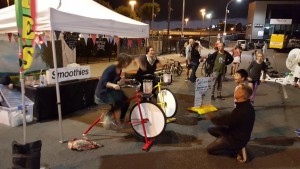
K Road is already a busy spot for cycling. In the 2014 cycle counts, across over 50 locations counted across Auckland, two K Road intersections (at Queen St and Symonds St) held second and third place for the greatest number of cyclists. And that’s without any cycleways on the road itself!
Since then of course, we added Grafton Gully and most stunningly, Lightpath to the area, a bold pink statement both reminiscent of one of K Road’s layers, and a modern gesture towards the future.
But what about cycling on K Road itself? What might bike lanes mean for people on bikes? And what will more bikes mean for local residents and shops?
What does the urban cycleway project mean for K Road, a place already changing in many ways? Especially when it will be much more than just a cycleway project, but also has the stated aim (and extra ‘non-cycling’ funding) of significantly improving the public realm, upgrading conditions for pedestrians, and transforming the area for the near future when the City Rail Link station will open on Mercury Lane.
Late last year, Bike Auckland was invited to take part in a Community Reference Group, set up to allow Council to draw upon experience and input from a wide variety of stakeholders – including local residents, local business owners, the local Business Association, and Generation Zero.
The group doesn’t make decisions – but helps Council and Auckland Transport make them, by raising all the ideas and concerns and hopes we all have for the project.
When we joined the group, we agreed to a confidentiality clause, to allow frank exchange before any designs go to the wider public. That clause is still active, so we apologise that we can’t really share plans or details from the discussion (although we may one day be able to do so retrospectively).
What we can say is that the process so far, across several meetings over the last few months, has been very rewarding. The authorities have put together a really good team from their side, who have put forward some great ideas, and have been very good in steering the process.
The discussions have been lively (and often about all the ‘usual suspect’ topics, like parking spaces) but also very constructive and respectful.
One key topic that has come up a lot is change: the degree of change, and reasons for not wanting to change – like wanting to retain what is valued, for whatever reason – whether it’s a specific ‘feel’ of the area, or some quite concrete thing. Will more bikes enhance that feel, or just be one of the many forces washing over the ‘old’ K Road? Of course we feel that more people on bikes (and on foot!) are the best way to really make an area lively and local – but not everyone will agree.
But there is also a lot of openness from most participating to the opportunities, somewhere along the spectrum between ‘This is great!’ and ‘Well, it’s coming anyway, so let’s roll with it and make it work.’ Sometimes even both at the same time, from the same people (K Rd is complex, and so are people!).
Some great discussions were had on the merits of K Road as a thoroughfare (harking back to the ancient Maori track) versus K Road as a place to stop and rest, or have a street party. How much traffic noise, and fire engines, and sheer ‘roaring through’ busyness should K Road have, and was there a risk that some of the design concepts might inhibit and ‘sanitise’ that vitality?
As a voice for people on bikes (but also as a group which has many fond memories of K Road ourselves) we of course focus on the bikeway. And as an engineer, I personally tend to focus on relatively technical aspects (again, I’m sorry I can’t talk shop about details of the proposed designs!). But we feel the designs we have seen are very exciting for all of K Road, not just those arriving on two wheels. Though it should be said that things still have a way to go until matters are locked in and decided.
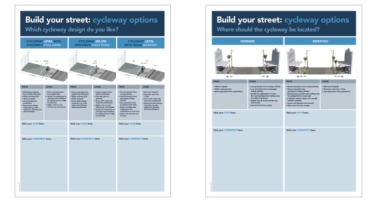
At the Open Streets event, Council will show be showing off a number of different protected cycleway options, and ask people for comment on how they feel the cross-section will look. We have shown a teaser image here (which we formatted intentionally small and blurry…), so you get a hint of what you will be shown tomorrow.
After this initial peek tomorrow, full public consultation should start in 1-2 months – and the Council team creating the design certainly doesn’t have an easy job peeling back all those layers of K Road.
But maybe we don’t really need to overextend that metaphor.
Maybe all we need is another layer of transformation, building on the old layers, without losing them. There will be more discussions along the way – but we feel very optimistic.

